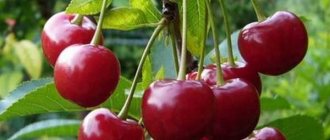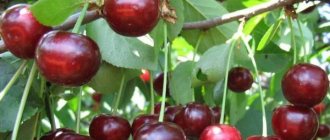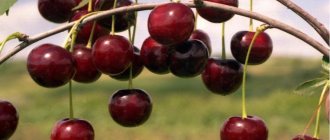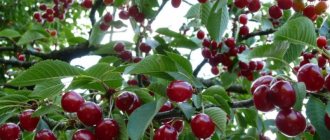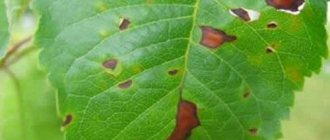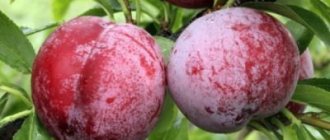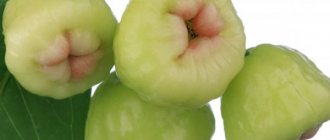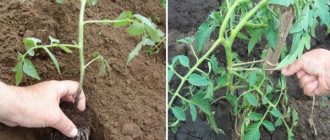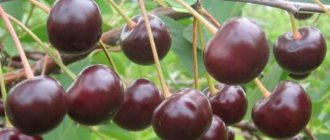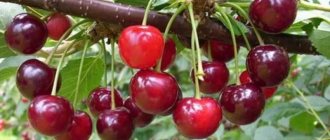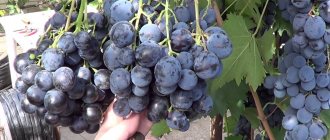Description of Zagorievskaya cherry
So, let's start the description of the Zagorievskaya cherry from the very beginning.
This variety of cherry was bred by employees of the All-Russian Breeding and Technological Institute of Nursery Growing and Horticulture. It has a fairly impressive list of advantages, which determined its popularity among gardeners not only in our country. This variety was bred by crossing the Lyubskaya and Shirpotreb black varieties. Externally, the cherry tree is a low-growing and bush-like tree. Its maximum height is about 2.3–3 m. The crown of the tree is spreading and wide, but not dense. Fruiting occurs on annual shoots.
Description of Zagoryevsky fruits:
The berries are characterized by a high content of macro- and microelements, organic acids, sugars, pectin, folic acid, and vitamins.
The fruits, after ripening, hold well on a short stalk. Therefore, they are separated from it with some effort. The berries have a universal purpose. They can be consumed either fresh or sent for processing to produce jams, juices, jams, and compotes. Various tinctures and liqueurs are also prepared from them.
The harvest begins to form approximately 3–4 years after planting the seedling. The flowering period occurs at the end of May. Ripe berries can be picked at the end of July and beginning of August. This variety is characterized by average yield. With proper and complete care, up to 14 kg of berries can be removed from one tree every year. From one hectare it is usually possible to harvest up to 10–14 tons of crop.
Zagoryevskaya cherry is self-fertile. Therefore, it is able to produce a good harvest even in the absence of other varieties of its fruit crop nearby. But the best pollinators for this variety are Shubinka, Lyubskaya and Vladimirskaya.
The trees are highly cold-resistant, which allows them to withstand severe frosts well. But in order to protect plants from freezing in regions characterized by harsh winters, trees of this variety must be additionally covered in the fall.
It is worth noting that the yield rate usually decreases after a harsh winter. This is due to the fact that at prolonged low temperatures the flower buds freeze.
The tree has average resistance to coccomycosis, as well as other types of fungal diseases. For good growth and stable fruiting, seedlings should be planted on light and fertile soils. The best option would be to grow trees on sandy loam or sandy black soil. To quickly establish seedlings, it is necessary to add slaked lime to the soil.
The plant does not tolerate stagnant water. Therefore, it should not be planted in areas close to groundwater. At the same time, cherries do not need special care. Only in the spring, when the snow has melted, preventive pruning is carried out. During this process, all frozen, diseased and damaged branches should be removed from the tree.
Having such characteristics, this variety of cherry can grow in almost any area. In Russia, this variety is usually grown in the southwestern and northwestern regions.
Zagoryevskaya is often used not only for producing tasty berries and creating orchards, but also for landscaping. Trees of this variety are often used for landscaping parks and squares.
Rastorguevskaya
A modern variety bred at the beginning of the 21st century. This means that breeders have corrected previous mistakes and obtained new results. Many people consider this variety to be the standard, although it has some disadvantages - moderate winter hardiness and susceptibility to coccomycosis (in especially wet years). However, the Rastorguevskaya cherry has much more advantages: it quickly begins to bear fruit, self-fertility (the ability of trees to set fruit without pollen of other varieties), and the excellent taste of large berries.
Juicy, dark red fruits, suitable both as a dessert and for any type of processing, as well as the low growth of the trees, make this variety one of the most beloved and desired in most of Russia.
Entry into fruiting Tree height (m) Fruit weight (g) Harvesting Pollinator varieties
For the 3rd year 2.5-2.7 4.0-4.1 Beginning - mid-July Self-fertile
In conclusion, I would like to remind all gardeners that it is advisable to plant stone fruit crops, which include cherries, in the spring, so the risk of freezing of still immature trees is minimized. But it is better to buy seedlings not only of the above varieties, but also of any others, in the fall, because the choice of seedlings is greater and the quality of the planting material is better.
Description of the cherry variety Vstrecha
The Vstrecha cherry variety is a hybrid obtained by crossing the Lyubskaya cherry and the Kyiv-19 duka (a hybrid of cherry and sour cherry). This tree is classified as a natural dwarf tree, since it grows weakly and does not exceed a height of 2 m. The spherical crown with drooping branches and large, rich green leaves with small serrations has a compact and attractive appearance.
The meeting attracts gardeners with its compactness of the tree and abundant fruiting
The variety is a mid-late variety and blooms from April 25 to May 5. Flowering and fruit formation occur on emerging young growths and bouquet branches of a four to five year old tree. The first berries begin to ripen in the second half of June (depending on the climate zone). The average weight of the fruit reaches 10 g. Shiny, with a dense dark red skin and sweet pulp, from which the stone can be easily separated, the fruits evoke the admiration of even the most experienced breeders. The form and “content” do not lag behind in assessments. The taste of the berries was rated by tasters with the highest score - 5. High yield (up to 28 kg per mature tree), versatility of the fruit in terms of use and suitability, excellent transportation of fresh berries are big advantages of their characteristics. Therefore, Vstrecha is ideal for growing both a single crop in dachas and individual farms, and in group plantings for commercial purposes.
An important advantage of cherries is its increased immunity to common crop diseases - coccomycosis and moniliosis, resistance to the arid steppe climate and severe frosts (down to -25 ° C). Unlike other varieties, Vstrecha grows well and bears fruit in the shade. Cherry is recommended for cultivation not only in Ukraine, where it was bred by Melitopol breeders Turovtsev, but also in all zones of the former Union, excluding the northern
Cherry is recommended for cultivation not only in Ukraine, where it was bred by Melitopol breeders Turovtsev, but also in all zones of the former Union, excluding the northern one.
History of selection
Workers from VSISP in the city of Biryulyovo worked on the creation of the Zagoryevskaya cherry. In the old days there was a village called Zagorje. The cherry tree owes its name to this place. The mother varieties were Lyubskaya, known throughout the country, and Cherny Shirpotreb. Initially, it was planned to grow Zagoryevskaya in the northwestern region, but over time it conquered much larger areas. To date, the variety has not been included in the state register, but this has not made gardeners’ love for cherries any less.
Read also: Choosing the best variety of gherkin cucumbers
Planting Kharitonovskaya cherries
If you bought a seedling with leaves, remove them, otherwise they may dehydrate the tree. After acquiring the tree, moisten the roots and wrap them with a damp piece of cloth and a film on top so that they do not dry out.
Drop off time
In the southern and central regions, cherries take root well when planted in autumn (in October before the first frost). In the middle zone, in order to avoid freezing of the tree, it is better to plant seedlings in early spring, when the frosts are already behind and buds have not yet appeared on the trees.
Choosing a location and feeding
Kharitonovskaya cherry variety is planted in a well-lit place. Avoid planting in lowlands, as water can accumulate there, which is detrimental to the plant. Groundwater should not be closer than 1.5 m from the soil surface. If they pass close, make a mound for planting. It is appropriate to plant the tree against the walls of a barn or next to a fence so that the cherry tree has some shelter from the wind.
Before spring planting, the soil for planting is prepared in the fall. Before autumn - 14 days. Podzolic, low-fertility soils are dug up, then the soil is mixed with fertilizers. Organic matter (rotted manure, peat, compost) is added at the rate of 7 kg per 1 m2, potassium fertilizers are added - 100 g, as well as mineral fertilizers - 200 g of superphosphate. Light sandy loam soils are dug up together with lime (400 g per 1m2); heavy loamy soils will require 600 g of lime. The cherry tree needs to be provided with suitable nutrition, so fertilizers are also applied to the hole during planting, but lime or nitrogen-containing fertilizers are not suitable for this purpose; they can cause burns to the roots, thereby weakening the plant. Apply 10 kg of organic fertilizers, 200 g of superphosphate, 50 g of potassium sulfate or 400–500 g of ash.
Superphosphate is an important mineral fertilizer for cherries.
Landing technique
When planting, use the following recommendations:
- Dig a hole 55–60 cm deep and 75–80 cm wide. Throw the top and bottom layers of soil in different directions. Don't forget that trees need free space, so leave 2-3 m between them so that they can grow properly and do not interfere with each other.
- Place a stake at the center of the hole.
- Sprinkle fertilizing on top with fertile soil (top soil removed when digging a hole) in a layer of 6–7 cm. This way the seedling will not come into contact with fertilizers and will not develop burns.
- Place the tree in the hole so that the root collar is 4–5 cm above the ground surface. After several waterings, it will settle to the ground level (this is how it should be). The root collar covered with earth will rot and the tree will begin to deteriorate. You should also not leave the roots uncovered, they will dry out and the cherry will die.
- Fill the hole with the remaining soil, straightening the roots and tamping the soil under them, avoiding the formation of voids. Compact the earth little by little, especially along the edges.
- Form a hole around the planted tree. Make a side around the edges; before the onset of winter, do not forget to remove it to avoid water accumulation.
- Pour 20 liters of water into the hole and sprinkle with dry soil, peat or humus.
- Tie the tree to the peg in a figure eight pattern so that the rope does not cut into the trunk. The stake should be lower than the first skeletal branch, so that when the tree sways in the wind, the branches do not rub against it and are not damaged.
- Cut the conductor so that it is 20 cm higher than the ends of the upper branches. Leave 5–7 skeletal branches arranged in a tier.
Set the stake first, then plant the cherry tree - driving in the stake after planting will damage the tree's roots
Preparing for winter
Zagoryevskaya is intended for cultivation in gardens of the northwestern and southwestern regions of the country. Despite the fact that the manufacturer notes the frost resistance of the variety, the plant should be additionally prepared for winter. Breeders advise feeding the soil around the trunk with horse manure in the fall, and wrapping the trunk itself with covering material. Polyethylene is not suitable for this purpose, since the plant must have access to rain and fresh air.
Read also: Fertilizing strawberries and raspberries with ammonia in spring: proper treatment of plants with ammonia
An additional preventive measure in preparing for winter will be the initially thoughtful placement of cherry seedlings. So, if the tree grows in places sheltered from the winds, this will protect it from freezing. You should choose places near the house, or better yet, between the house and the summer kitchen or bathhouse.
What happens if a cold winter comes without snow, and the plant was not prepared for the vagaries of nature? Flower buds will most likely freeze, which will negatively affect the quantity of the next harvest.
Description
The root system of trees consists of two tiers:
- The bulk of the horizontal roots are located at a depth of 50 cm, and on poor, sandy ones they rise to 20 cm;
- Vertical roots are directed strictly downwards and grow up to 2 m in depth.
Cherry - a tree 5 - 7 m high or a shrub, 1.5 - 2 m in size
A positive property of the former is the accumulation of basic nutrients from the upper layers of the soil. A negative quality is the growth of numerous root shoots that litter the garden.
Deep roots supply water from deep in the soil and give stability to the above-ground part. Thanks to this, cherries are not afraid of wind.
A cherry tree grows up to 40 years old, but bears fruit intensively between the ages of 3 and 20 years
It is important to consider the structural features before planting trees to ensure a bountiful harvest in the future. Bush cherries have a wide, dense, spreading crown, 1.5 - 2 m in size. Shoots grow in a bunch from the ground
Some varieties are distinguished by a weakly defined trunk with highly branched stems. These plants require less space than trees
Shoots growing in a bunch from the ground. Some varieties are distinguished by a weakly defined trunk with highly branched stems. These plants require less space than trees
Bush cherries have a wide, dense, spreading crown, 1.5 - 2 m in size. Shoots grow in a bunch from the ground. Some varieties are distinguished by a weakly defined trunk with highly branched stems. These plants require less space than trees.
Felt cherry is a typical representative of the bush group
Despite their external differences, all cherries are different:
- Unpretentiousness to growing conditions
- Annual fruiting
- High frost resistance - can withstand low temperatures down to minus 30 C, some varieties up to minus 35 C
The decisive factor for planting cherries is the choice of a variety or hybrid suitable for local climatic conditions.
Description of Zhivitsa cherry
The plant has an almost straight trunk and a rounded crown, slightly elongated from bottom to top. The density of the branches is average, the foliage is high. The branches are raised and sagging. The color of the trunk is brownish-gray.
The leaves have an elongated shape. Their sizes are about 12 cm in length and 3-4 in width. Color – rich green. Most of the buds are formed on the shoots of the current year.
The flowers are small and white. The flowering period begins in mid-May. The variety is self-sterile, that is, fruiting without pollinators will be practically absent.
Top of the crown of the Zhivitsa cherry
The variety is classified as early ripening and winter-hardy. Recommended for cultivation throughout Belarus and Ukraine, as well as in central Russia. However, due to its good frost resistance, it adapts well to colder regions. There is numerous evidence of the successful cultivation of Zhivitsa cherries in the regions of the Urals and Western Siberia.
The hybrid has also adapted in the South. It is successfully grown in the North Caucasus and the Astrakhan region, although it has no commercial importance in these regions, since more productive heat-loving varieties can be grown in them.
Dimensions and height of Zhivitsa cherry
The diameter of the plant trunk rarely exceeds 10-12 cm. The rounded crown measures from 1.5 to 2.5 m. The height of the Zhivitsa cherry can range from 2.5 m to 3 m.
Description of fruits
Zhivitsa cherry berries are round in shape and medium in size. Their weight does not exceed 3.7-3.9 g. They have relatively fragile, delicate skin of a dark red color. The pulp of the hybrid is dense, but at the same time very juicy. It has the same color as the skin. The stone is small in size, freely separated from the pulp.
Ripe Zhivitsa cherry fruits
The taste is rated as very good, approaching excellent. There is a barely noticeable sourness in it. On a five-point scale, the taste of Zhivitsa cherry is rated at 4.8 points. The use of fruits is universal; they are consumed raw and processed. When preserved, they perform well, do not wander or explode.
Pollinators for Zhivitsa cherry
All cherry-cherry hybrids do not yet have self-fertile specimens. This is a serious problem for breeders, which they have been struggling with for decades. Cherry Zhivitsa was no exception. In addition, it does not have the possibility of cross-pollination with its own variety or related ones. For this purpose, all Dukes need only parent cultures.
The previously mentioned Griot and Denisenu can be used as a pollinator, but the use of closely related varieties is also acceptable. These include: Seedling No. 1, Novodvorskaya, Vyanok.
As a last resort, you can try to pollinate with an unrelated crop. Any variety that blooms around this time (1-2 decades of May) is suitable for this task. It is possible that it will be possible to find a previously unknown effective pollinator for the Zhivitsa cherry.
Attention! The greater the varietal diversity of cherries in the garden, the greater the likelihood of successful fruit set of the hybrid in question. According to gardeners, the minimum required number of pollinating varieties for Zhivitsa cherry should be 3-4
According to gardeners, the minimum required number of pollinating varieties for Zhivitsa cherry should be 3-4.
Landing Features
Time and place
The time for planting a Kharitonov cherry seedling depends on the region where it will be grown. In central Russia this is the end of March - beginning of April. In the south of the country and in the central regions, it is preferable to postpone planting until autumn (until October). The main requirement and guideline for this event is that it must be carried out before the buds begin to swell.
Find an open spot for the cherry tree so it can get more sun.
Cherry prefers sunlit places, preferably on sandy loam. The soil acidity level should be neutral. Heavy clay soils, as well as places with high groundwater levels and lowlands where water stagnates, are not suitable. In the place where the cherry grew, you cannot plant it again for the next 3-4 years.
Selection of planting material
A healthy seedling can be determined by its appearance and, above all, by its root system, which should be well developed and about 20–30 cm long. It is easier to choose a seedling in the fall - it has leaves, by the appearance of which you can make a conclusion about the health of the cherry. In the spring, the selection process becomes a little more complicated. However, there is one old and proven trick - just lightly scrape the bark from a trunk or shoot, and if a layer of green fibers is found under it, then the seedling is alive and ready for planting.
You need to purchase seedlings only in trusted places - nurseries, garden stores and centers where planting material is brought from the same nurseries. The buyer is offered two options of cherry seedlings to choose from - grafted and own-rooted. The choice should be made in favor of the former, since such plants tolerate low temperatures better and produce greater yields.
Soil preparation
The soil at the planting site must be prepared in advance. If planting is done in the spring, then it is done in the fall, and if in the autumn, then at the end of spring. For the seedling, a hole is dug one meter in diameter and 80 cm deep. The removed soil is mixed with 15 kg of humus, which can be replaced with the same amount of compost, 200 g of superphosphate, 60 g of potassium sulfide and 500 g of wood ash. The hole and roots of the seedling will be filled with this mixture. Quicklime is also used in the amount of 500 g, which is diluted in 10 liters of water and poured into the pit.
Step by step process
Try to prepare the ground for planting in advance and do not forget to add fertilizers.
Before planting the seedling, its roots are dipped in a clay mash, after which they are left to dry for half an hour. The recipe for mash is simple: add enough clay to 10 liters of water so that the resulting mass is similar to sour cream. A Heteroauxin tablet and a bag of any drug that stimulates root formation are added to this solution. All that remains is to add 1 kg of rotted manure and mix well.
- In a planting hole filled with a nutrient mixture, dig a depression with a diameter of 80 cm and a depth of 60 cm, and at the bottom a tubercle is made into which a peg for gartering the tree will be immersed.
- The cherry seedling is installed so that its root collar is 5–7 cm above ground level, after which the roots are sprinkled with earth, and the plant is periodically shaken by the trunk so that there are no voids left between the roots. When the hole is filled, the soil around the cherry tree is compacted, and then a small mound is erected almost to the root collar. In this case, when the ground subsides, the roots will not be exposed.
- A circular mound of soil is formed around the seedling in the tree trunk circle, thereby creating a hole for watering from which water will not flow out.
- The seedling is tied to a peg, but not too tightly so as not to interfere with the growth of the cherry.
- Now all that remains is to water the tree with three buckets of water and mulch the tree trunk circle with straw, rotted sawdust or peat. The plant is pruned at a height of 70 cm.
Feeding, crowning, wintering
Let's talk a little about feeding. In the first couple of years, planting will not require the application of fertilizers and fertilizing at all for the reason that they will be saturated with all the necessary substances and components from the saturated and enriched soil. But after two or three years, it is still necessary to begin adding additional fertilizers and substances so that the plantings can feel much more comfortable. Typically, fertilizers are applied in the autumn, before the gardener orders in-depth digging of the garden plot. So, for one cherry tree we will need to apply potassium fertilizers, phosphorus fertilizers (all these fertilizers are applied mainly in dry form).
In early spring, it is necessary to make the soil saturated with nitrogen-containing components. This will require about fifty grams of fertilizer, which will be ideal for saturating the planting and creating the most favorable conditions for it. You should not be overzealous with fertilizing, as you can quite overfeed the planting and cause harm to it. And in general, experienced gardeners say that it is better not to feed the planting more than to create satiety conditions for it, in which the cherry will experience discomfort. But if satiety suddenly occurs, then it is recommended to leave the planting alone for a while, not to apply any additional fertilizing, so as not to make it even worse. Gradually the tree will rest and recover.
When the Rastorguevskaya cherry reaches the age of two years, then crown formation should begin. To do this, the branches are pruned. They carefully inspect the planting, shorten the growths so that the plant looks not just neat, but also healthy. If the cherry tree becomes very old, then gardeners are recommended to carry out anti-aging pruning. Thanks to it, the tree can be given a second life. It is worth keeping in mind that, in principle, trees tolerate these procedures quite calmly and recover normally after pruning and shaping.
Frost protection is another important requirement that gardeners must maintain. The fact is that the winter period can be very harsh, both for adult plants and young seedlings
Therefore, it is necessary to protect plantings using materials such as glass wool and roofing felt, reeds, spruce forests, and thick paper. If the trunk has been damaged by rodents, pests, or mechanically by the gardener himself, then the damaged area is carefully cleaned with a knife and lubricated with garden varnish to prevent further penetration of infection into the bark. It is better to tie the trunk on top with a dense material that will allow a small amount of air to pass through.
In general, it is worth saying that the Rastorguevskaya cherry seedling is a fairly good option, especially if the gardener plans to plant cherries in the Central region. The fruits are quite versatile; they can be used fresh, or you can prepare a large number of dishes, drinks and preparations from them. The most important thing is that the taste characteristics of Rastorguevskaya cherries are rated very highly, and they go well with other berries and fruits. I would also like to note that in general, Rastorguevskaya cherries are also a very useful product, which is prescribed for the organization of dietary and baby food. So not only adults, but also kids will like the taste of Rastorguevskaya cherries.
Features of cultivation and subtleties of care
Meeting does not differ from other varieties in its special care requirements. It is only necessary to follow some rules and agricultural practices:
Watering is carried out 3–5 times per season, depending on climatic conditions. For a young seedling, 1 bucket in the trunk circle is enough, for an adult tree - 3-4 buckets. Cherries especially require watering during the period of appearance and growth of annual growth, during flowering and ripening of berries. In the latter case, it is not recommended to water the tree if the ground is very dry, since the fruits may crack. There is no need for watering in rainy weather. But after a dry summer, cherries need to be recharged with moisture by adding 10 buckets of water under mature trees. The tree is fertilized 3 years after planting. In late autumn, you can add 2 buckets of humus or compost from plant residues under each seedling, evenly distributing them over the entire tree trunk circle and digging them onto the bayonet of a shovel. In early spring, when the buds have not yet had time to bloom, cherries are fed with ammonium nitrate (20 g), superphosphate (10 g), potassium salt (5 g) per 1 m2 of trunk hole
After flowering and during fruit set, an aqueous solution of wood ash in a ratio of 1 l/10 l of water or urea (2 tbsp/10 l) would be a good fertilizer. The soil in the tree trunk circle is loosened at least 2 times per season, removing weeds. Of no small importance for cherries is the procedure of liming the soil, which is sufficient to carry out once every 4 years. Apply 0.5 kg of lime per 1 m2 of tree trunk circle
Thanks to this, the acidity of the soil is normalized and the absorption of nutrients by the root system of the tree is improved. In addition, calcium is necessary for the formation of fruit seeds. In early spring, sanitary and formative pruning of the cherry tree is carried out. Remove dried, weak branches that thicken the crown, and trim off the emerging young shoots.
